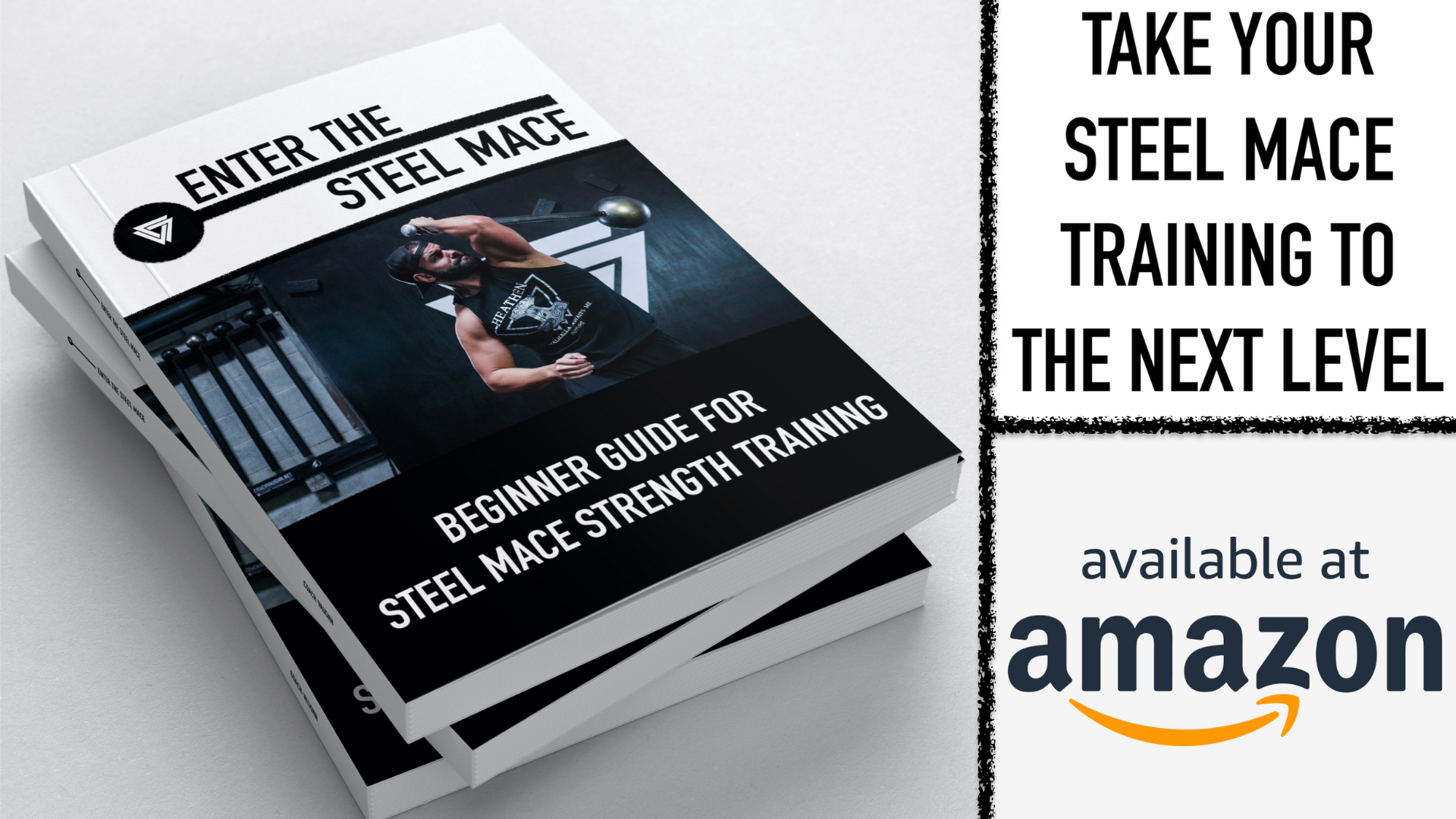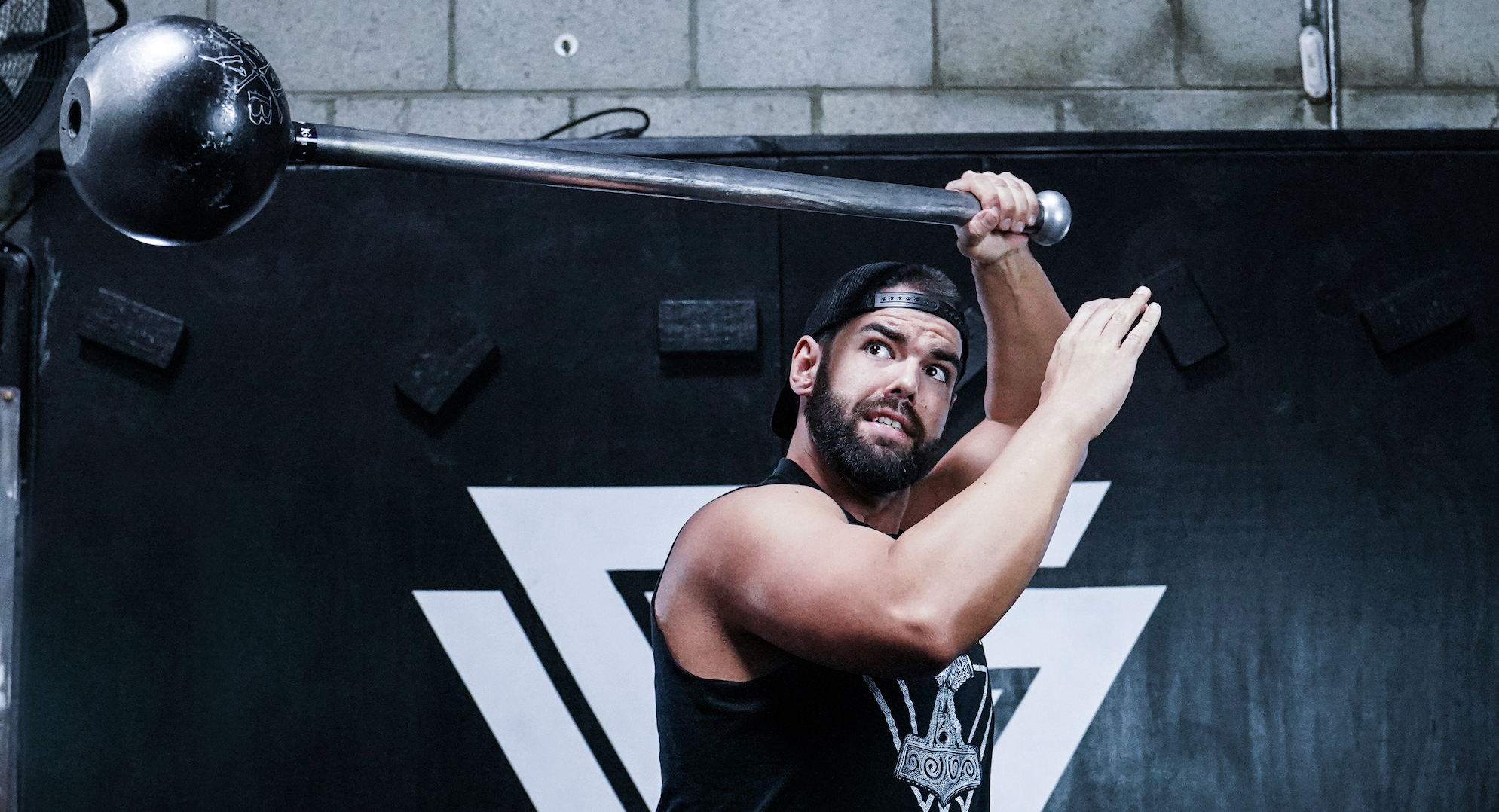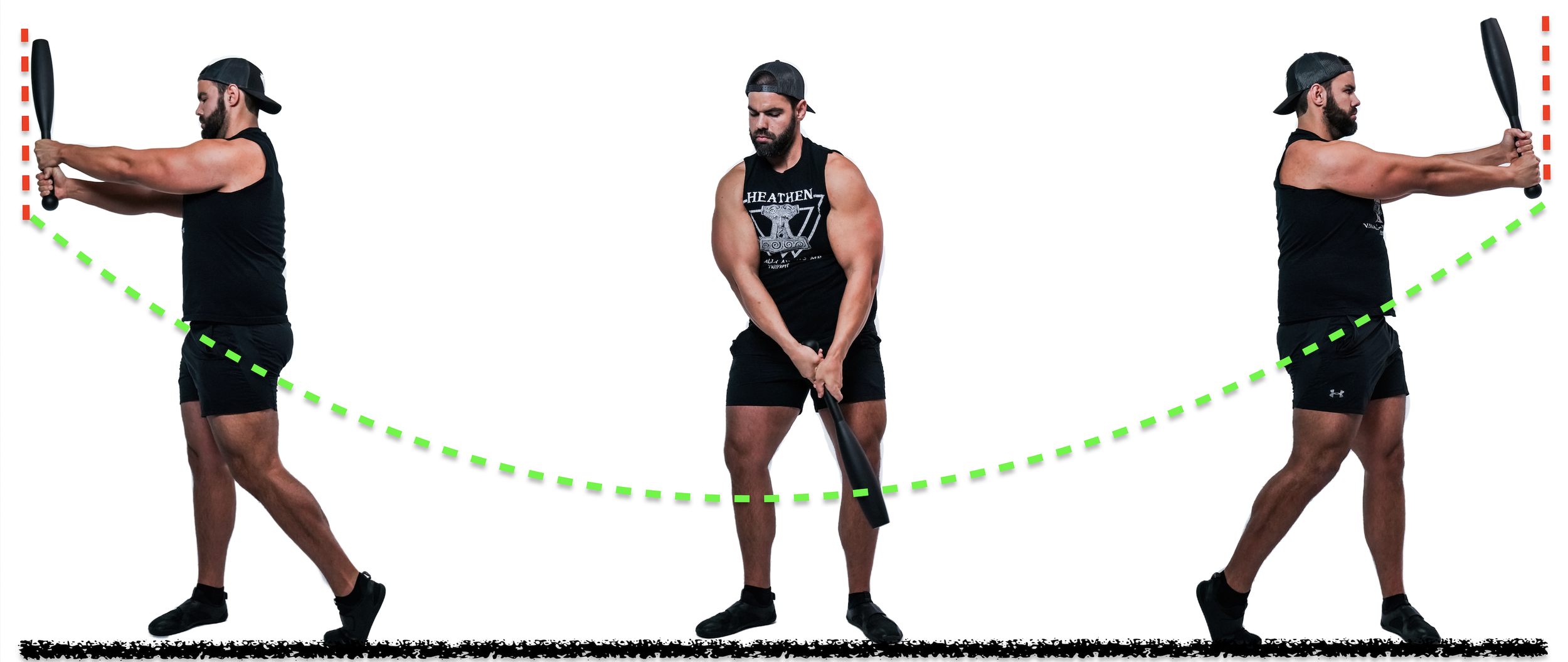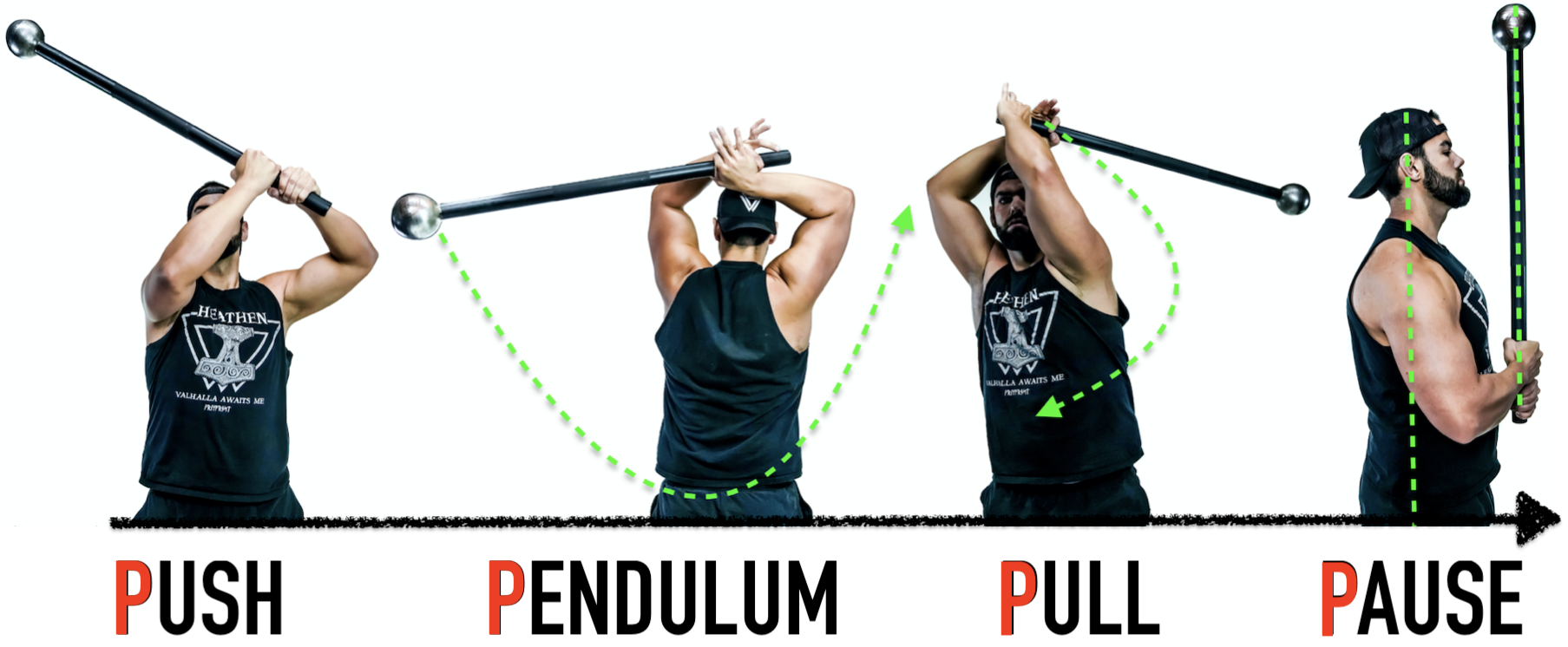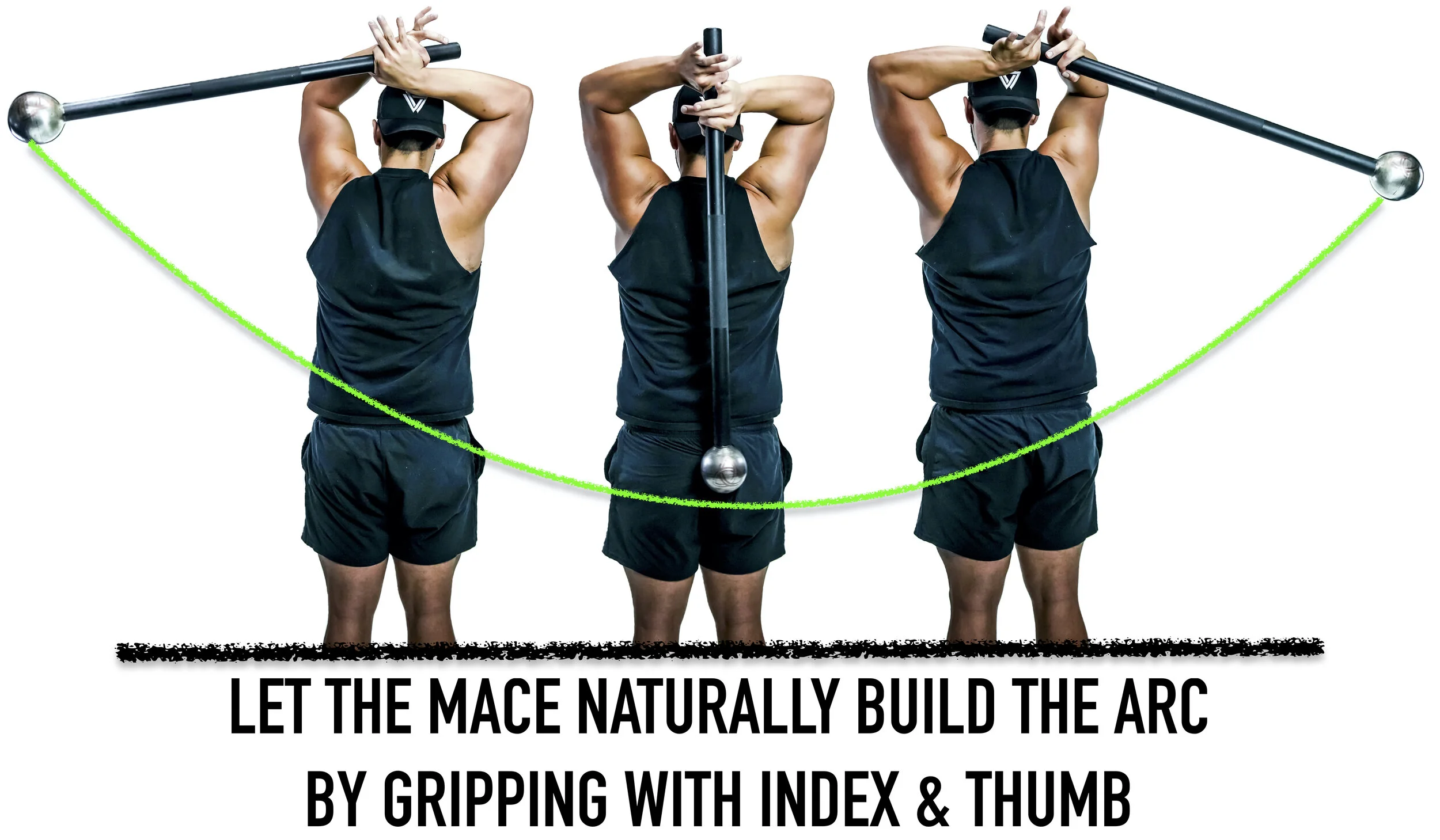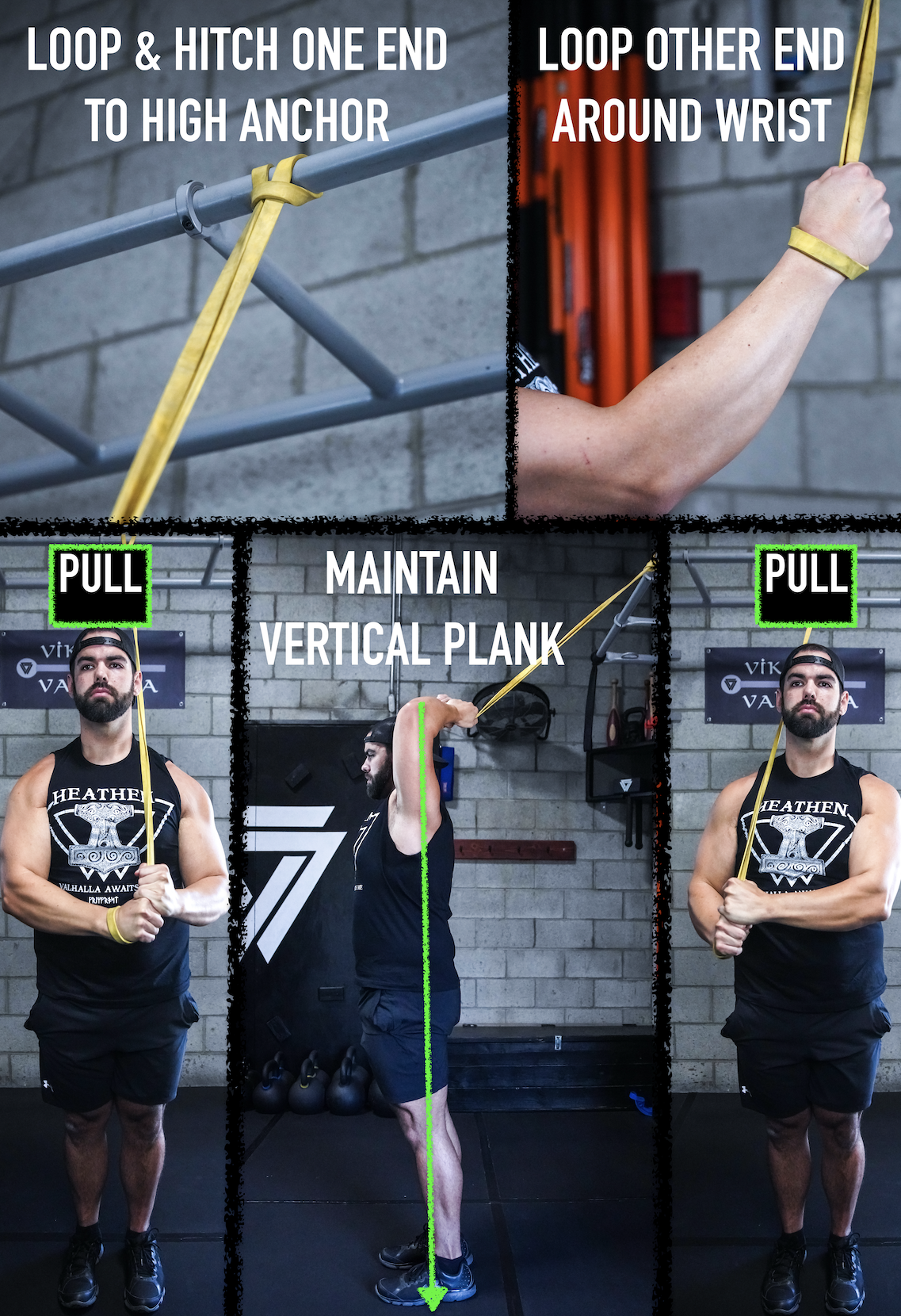Best Indian Club Exercises For Beginners
Indian clubs are one of those tools that has withstood the test of time, and have been around for thousands of years in India before making it western culture. Great advocators like Dr. Ed Thomas helped promote Indian clubs to become a staple in many’s fitness routines, and became one of the best investments I’ve made in my personal and professional fitness career.
So I put together this two part series on how to get started with your Indian clubs with these exercises best suited for beginners.
For more Indian Club workouts, be sure to check out my ebook program, GADA Club Guide for Indian & Steel Club Strength Training. Features over 30 indian club warm up drills and 40 workouts steel club workouts (with 150+ exercises with all private hyperlinked video content). Click HERE to download your copy.
Answering The Most Asked Questions on Macebell 360s
This is a tool that's gotten immensely more popular since I published my first workout with it back in 2016 to now in 2024. Way more people seem to know about it and have way more questions specifically on the steel ma 360. I've been practicing steel mace 360s for a decade and have gotten stronger with it swinging as as heavy as 32kg/70lb steel maces.
In this video below, I answer these top 3 questions I get the most with macebell 360s:
“Which hand pushes…Top or bottom hand?”
“When can I go heavier with macebell 360s?”
“My shoulders and elbows hurt during 360s . . .why?”
If you’d like to get better and stronger with your macebell 360s in detail — check out my book, Enter The Steel Mace, now available on Amazon. It features hundreds of HD photos like the ones above, and a full beginner program that can be downloaded through a QR code.
Macebell or Clubbell First?
In this new video below, I’ll be answering a very common question in my YouTube comment section:
“Which one should I get first? A Macebell or Clubbell first?”
In summary from the video above - while “get both” is an easy answer — I would never recommend a complete novice to learn how to use both a macebell and clubbell at the same. It really depends on what your goal is (especially if past injuries are currently affecting your current goals). While macebells and clubbells are asymmetrically loaded tools, and have great swing variations — they’re differences matter just as much.
To help you make decision, here are bullet points on the highlights for each
MACEBELL / STEEL MACE:
Great tool for a solid warm up tool before kettlebells or barbells
Helps balance unilateral strength between shoulders with 360 pattern swings
Would NOT recommend if you have serious shoulder and elbow issues
Only a 10lb macebell is needed for beginner women
Only a 15lb macebell is needed for beginner men
CLUBBELL / STEEL CLUB:
Builds dynamic grip strength with it’s elongated shape
Great for building rotational power for baseball, golf, or MMA
Much better option for those with serious shoulder and elbow issues with it being half the length of mace.
Can be worked with singles and doubles (giving more variations than maces)
Only a 10lb Single and 5lb doubles is recommend for women
Only a 15lb Single and 10lb doubles is recommended for men
If you’d like to know more, I have more articles with free workouts featured below on both these tools for beginners:
I also have plenty of ebooks programs showing how to safely integrate these tools together. You can save 20% off on single ebooks with code VVV20 at checkout or bundle them saving over 40% off
Why Indian Clubs?
Being a fitness coach for over 15 years — I’ve pretty much seen it all with equipment trends over each decade. Many tools gain popularity, but rarely stand the test of time. In my opinion, if you can’t explain the “why” behind the tool . . . then there’s no real philosophy behind it.
However, Indian clubs are one of those tools that has withstood the test of time, and have been around for thousands of years in India before making it western culture. Great advocators like Dr. Ed Thomas helped promote Indian clubs to become a staple in many’s fitness routines, and became one of the best investments I’ve made in my personal and professional fitness career. So in this video below, I explain why Indian Clubs should become apart of your arsenal if you want to make fitness a long-term plan.
Learning to deal with a separated shoulder was a defining moment in my fitness career because it taught me how the body functions in response to stress and injury. One of the scariest moments (months after the injury) was when I just finished a heavy dumbbell pressing workout and felt as if my entire right side was shutting down. While it wasn’t a stroke, a nerve was getting impinged in my shoulder and causing serious numbness. After that day, I decided not to lift any heavy loads until I had fixed my problem. I refused surgery because I knew too many people who ended up worse after becoming addicted to medication to deal with the constant pain.
So when I found indian clubs to input into my new routine — I got great results being able to press heavy again without any pain or numbness. Now, I’m not stating by any measure Indian Clubs “cure” shoulder pain — it took months of patience of learning HOW to use this tool with a consistent routine. Dr. Perry Nickelston (Stop Chasing Pain) asks: “What do ALL injuries have in common? You don’t move the same after.”
So as referenced in the “Why Indian Clubs” video above. Here is the Beginner Indian Club Metronome Mill Workout to show you how to utilize them with control, speed, and dexterity. You can download the metronome app here for free when utilizing the BPM:
These indian club drills have been a part of my warm up routine for years. They can help rid a lot stiffness in the body and shoulder pain from poor posture patterns. As we get older, we must gain new knowledge to combat these tough lessons in life.
For more Indian Club workouts, be sure to check out my ebook program, GADA Club Guide for Indian & Steel Club Strength Training. Features over 30 indian club warm up drills and 40 workouts steel club workouts (with 150+ exercises with all private hyperlinked video content). Click HERE to download your copy.
Beginner Guide to Macebells
The macebell is an unconventional tool to help build grip strength, shoulder resiliency, and can give one hell of a total body workout. The problem is when most get them in the mail finally…they have no idea what do with a macebell workout wise. Luckily, I‘ve put together a lot of beginner macebell workout videos over the years to help guide you in the right direction toward moving better and stronger with your mace.
The workouts below will help build your skills with your macebell at safe pace. For beginners, I recommend men go heavier than 15lb macebell and women go with a 10lb macebell (click to view Onnit Steel Maces). While it may seem like much weight . . .trust when I say the macebell will put you in your place when performing these strength building exercises. Each video below progresses from beginner, intermediate, and advanced levels with your macebell.
Hope you enjoyied this Beginner Macebell Guide, and if you’d like to see more macebell exercises like these — check out my book, Enter The Steel Mace, now available on Amazon. It features hundreds of HD photos like the ones above, and a full beginner program that can be downloaded through a QR code.
Beginner Guide to Clubbells
If you’re getting into clubbells (or steel clubs), you may a bit lost on where to start on how this tool can be implemented into your workouts. Typically, most are aware of kettlebells and steel maces when curious about clubbellls (that’s personally, how I got into them in 2016). However, just in case you are unaware — what all these tools have in common (pictured below), it is their center of mass is distal from the handle (being asymmetrically loaded). Making them perfect for ballistic athletic movements like swings, cleans, 360s, and snatches.
I’ve become well experienced with all these tools for almost a decade, and can tell you with confidence out of all three . . . clubbells are the most challenging because they combine the best of both worlds from steel maces and kettlebells. Steel maces are critically known to have a very long handle (far left), and kettlebells have a very short rounded handle (middle). This is where clubs are in the middle ground being distally loaded between the two (being not too long, and not too short).
Beginner Clubbell Weight Recommendations:
So with all this in mind, it’s important a beginner knows where to start weight wise. Many think getting a 20LB+ clubbell will be a good start, and this will not only be a waste of money, but will risk injury. Trust me when I say, clubbells WILL strike down any ego you may have thinking how strong you are (even if you have kettlebell experience). So please take the listed recommendations below from someone who has not only used them for years, but has coached many one on one when first beginning with clubbells:
What’s great about clubbells is we can work with two, and single handed positions with a single. Then advance the foundational clubbell movements with doubles. I personally use Onnit Steel Clubs at my gym, and in my YouTube video tutorials.
How do I workout with Clubbells?
Luckily, my YouTube channel is well known for clubbell (or steel club) workout tutorials since 2016, and have recently updated a new series for 2024. Below are three workouts that evolve from beginner, intermediate, and advanced so you can get the most out your clubbells with both singles & double variations. All the repetitions and sets are listed after each following video tutorial below:
So if you liked what you read and want to progress your skills with clubbells — checkout my ebook program GADA Club: Guide for Indian & Steel Club Strength Training on sale now and can be purchased HERE. It features 30 different indian club warm up drills before you get into the strength training with your 40 steel club workouts. If you’d like to know more about indian clubs, I also wrote another article on them HERE. I hope I gave you a better understanding about steel clubs and what they can offer for your fitness regimen.
USE CODE: GOINGCLUBBING10
Why The Kabuki ShouldeRok Is Overrated
One of the most frequently asked questions I recieve “is the Kabuki ShouldeRok is worth getting” instead of multiple fixed weight steel maces. I’ve known about this product since 2014, and still continued to buy heavier steel maces as heavy as 32kg/70lbs. This plate loadable mace is invented by Chris Duffin (a record holding powerlifter & owner of Kabuki Strength), and claim on their website:
“The ShouldeRok™ was designed to increase shoulder strength, core stability, and rotational strength, as well as encourage proper spinal position and shoulder mobility/function.”
Going into 2022, my curiosity finally got the best of me because I continued to get YouTube comments and emails about this product. So I pulled the trigger, and bought one to see what the hype was about, and after two weeks of use . . . I have no idea why the Kabuki ShouldeRok is so popular. So I put together this video review below to show you in detail why you sould stick with regular fixed weight steel maces and steer clear of this questionable product design.
Problem #1 - The Price:
Here is the receipt after my purchase, and it came out to $233.43 to get this to my door. I don’t need to be an economics professor to breakdown if you got three or four steel maces between 7lb to 20lbs . . .THAT WOULD COST LESS. Not only that, you STILL have to buy the 5-10lb barbell change plates to load this thing. So you’re already paying over $300+ for a loadable mace.
Problem #2 - The Nut Is Weak:
Right out the box, I heard slack between the nut and swivel lathe with a cheap ringing sound. So before I published this review, I reached out Kabuki’s Customer Service to ask them if this was normal, and if I got a bad one off the production line. The rep relied:
“Thank you for reaching out to us at Kabuki Strength. The ‘play’ you are seeing with the nut on the ShouldeRok is typical when a plate is not attached. Once you introduce a change plate and use the nut to tighten it, you should no longer have that issue. If the nuts are any tighter, once you apply weight, say a 5lb or more, the tension will increase greatly and it becomes very difficult to remove the nut after use. I hope this helps.”
As you will see and hear in the review video, it does the exact opposite of what the rep said. It is insanely surprising to me there is not a rubber gasket on the nut to increase the friction against the swivel. With Chris Duffin being a 1,000lb deadlifter, he knows that even barbell collars have rubber on the insides to increase surface friction against the barbell sleeve so the plates don’t move. Yet, this fact is completely ignored having metal on metal with the nut and swivel lathe on the ShoudeRok.
Problem #3 - Loading Space:
You’d think with this being so expensive — it could be loaded to 50lb no problem. However, there’s less than 2 inches of loading space on this thing with the nut applied. So for example, three 10lb plates or a pair of 25lb will NOT fit. Empty by itself, the Kabuki ShouldeRok is 8lb — so you'll be lucky to load it SAFELY no heavier than 25lb.
Problem #4 -25lb Plates Are NOT 360 Safe:
Maces are commonly used for 360 motion patterns around the body. Most think the mace will hit your back if you do 360s, and that is only true if you swing it with bad form. However, when swinging the ShouldeRok with a typical sized Standard 25lb plate . . . it was WAY TOO CLOSE for comfort. The handle is 48 inches long (which is the same height as the Onnit Quad Mace), and I felt the back of my knee hairs getting hit and felt the need to kip my hips forward so it wouldn't take them out from behind. So 5-10lb plates can only fit on this over priced half barbell bar.
So with all these issues, The Kabuki ShouldeRok is not worth your hard earned money. It’s worth $119.99 at best, needs a rubber gasket in the nut, and needs a minimum of 4 inches of loading space for me to to see any value in this thing. The only positive I got out of this was the customer service allowing me to return this and get a refund.
If you’d like to see more steel mace related reviews —check out these reviews:
— The Best & Worst Amazon Steel Maces
— The Best HEAVY Steel Mace Brands
Steel Mace HEAVY 360 Ladder Workouts
Most when getting into steel mace training, are addicted to 360s . . . me included. I’ve been swinging this tool since 2014, and still love getting in a workout with my heavier maces 2-3 times a week. It’s hands down one of my favorite unconventional tools to get stronger with — so much so I can swing a 25kg / 55LB steel mace with ease for reps now. Inevitably, the question came up often among my subscribers, “how do you build strength toward swinging a heavier steel mace?”
My methods toward building strength with heavier steel maces is simple . . . however many confuse that word with easy. A big part of the system is keeping the reps minimal with optimal rest times (usually 1-2 minutes after both directions or sides). I’m not a fan of going as heavy as possible, with as many reps as possible, with zero rest times — it’s complete recipe for injury with any tool.
Secondly, you need at least 3-4 different steel mace weights (if you have more that’s even better). This is so you treat each mace as a rung to make a ladder going up and back down in weight. As you will see in the Steel Mace HEAVY 360 Ladder Workouts below, we will not only being doing two handed (2H) 360s (Part 1), but single arm (1H) variations to get your grip strength even stronger (Part 2).
If you want to see an in-depth review of all the heavier steel mace brands I own and use for these workouts — you can check them out here featured in the video below:
Onnit Quad Mace - 25LB
Wolf Brigade Mace - 35LB
Apollo Steel Mace - 40LB
Agastu Steel Mace - 55LB (No longer in production)
White Lion Steel Mace -70LB
Hope you enjoy these workouts, and if you’d like to see more steel mace exercises like these — check out my book, Enter The Steel Mace, now available on Amazon. It features hundreds of HD photos like the ones above, and a full beginner program that can be downloaded through a QR code.
Steel Club Training FAQ
While steel clubs are making gains in popularity in people’s garage gyms and workout programs — they’re still many questions to the common outsider seeing these for the time and as well for the beginner who feels lost when working out with them.
Steel Club 2H Deadstop Side Swings
So I put together this “Why Steel Clubs?” video to better educate those curious about this tool and why it’s worth investing.
If you’d like to see more and have a better guide to show how to use steel clubs with a full workout program — check my ebook, GADA Club: Guide For Indian & Steel Club Strength Training here on the site. It features educational chapters with video tutorials breaking down the all steel club foundations for BOTH singles and doubles. Then the workout program is broken into beginner, intermediate, and advanced levels (with 12 workouts in each level). Every exercise is hyperlinked so know exactly what do with confidence and strength with your indian and steel clubs. To save at checkout, use code: GOINGCLUBBING10
Steel Mace Fighter Workout
What I love about the steel mace is it’s scalability. I can use it to train a basic beginner wanting to simply move better or I can give a hell of workout with it for a high endurance athlete. In this case for this article, a fighter in boxing, MMA, Jiu Jitsu, and many other forms of marital arts can highly benefit to adding in steel maces to their workout routine. Maintaining a high level of focus to defend and striking quick with power usually what it always boils down to with fighter athletes. So the steel mace’s asymmetrical load can be put into high use with uppercut, ground & pound, and ballistic hip hinge swing patterns to build on that power.
First, lets breakdown all three exercises in this Steel Mace Fighter Workout video:
Steel Mace Uppercuts:
Steel Mace Ground & Pound:
Steel Mace Rotational H2H Swing & Catch:
Hope you enjoy this workout, and if you’d like to see more steel mace exercises like these — check out my book, Enter The Steel Mace, now available on Amazon. It features hundreds of HD photos like the ones above, and a full beginner program that can be downloaded through a QR code.
The Kettlebell Awaits Book Preview
The Kettlebell Awaits paperback book is now available on Amazon. Features 100+ pages with HD images breaking down swings, cleans, snatches, presses, squats, and get ups in full detail with a downloadable kettlebell workout program — CLICK HERE TO YOUR COPY
The Most Underrated Steel Mace Exercises
With steel maces gaining popularity in garage gyms post 2020, it’s easy to become enamored with TOO much information with any new tool. And the steel mace consensus you’ll seem to get with every popular social trainer is hundreds of repetitious 360s are the path to “healing your shoulders.” While I love performing 360s (two and one handed) myself — it is a huge myth that steel mace 360s heal or cure your shoulder girdle from a complete novice standpoint. If anything, it can worsen one’s acute/chronic shoulder injury forcing without proper instruction from a fitness professional.
What I’m getting here is steel mace 360s are dangerous if a beginning individual has no idea how to stabilize these circular forces with out knowing how to use their lats (the big muscles wing of your back) or oblique system (sides of your core). It’s the same reason why I coach the kettlebell deadlift before teaching the kettlebell swing — so the beginner understands how to hip hinge properly to not injure their low back. So with the steel mace being a asymmetrical loaded tool what would be a good exercise to slow down this process to learn how to use these muscle groups?
Enter the Steel Mace Offset Military Press (watch video below for demo):
Now learning to press the mace, lets learn to pull it with the Bent Over Row next:
So by integrating these two exercises into your workouts, you can start learning steel mace 360s with a better knowing of HOW to use your lats and obliques to better control the steel mace (not letting it control you to the point of injury). If you’d like to see more of how to Master The Four P's For Steel Mace 360s — check out this article here to show you how.
Hope you enjoyed this article, and if you’d like to check out my ebooks programs showing you how to use your steel mace with kettlebells, steel clubs and bodyweight drills — view them here. Use the codes in red below to save at checkout or bundle them saving up to 25%.
Differences Between Indian & Steel Clubs
Clubs are finally starting to become more mainstream in the strength world. However, many are confusing Indian and Steel clubs . . . as the same thing? One is built for speed and the other is meant for raw grip strength. Watch this video breaking down the differences between the two:
As soon as I posted this video, I knew I was going to get inevitably bashed by Club Traditionalist linking videos of their origin (which is exactly what happened). I’m very aware of Traditional Indian Club Training methods with larger clubs/gadas in all shapes & sizes. This video explains the MODERN use of light Indian & heavy steel clubs for those in western culture who have no idea how or even what clubs are because it's not a common tool in the west. Hence, why I constantly reference American sports like baseball & football in this video to help relate the common movement patterns with them.
Modern steel & wooden clubs of this sort are getting popular because they can be shipped easier with less cost. Very few will spend the money to ship out (or even make) a giant wooden sized Gada, Jori, Karela, or Meel from another country (let alone make space or train someone with it). So if you want to train traditional...do so (and I'm not saying it's wrong by any degree). However, this is how clubs are becoming modernized in the west thanks to researchers like Dr. Ed Thomas and Gray Cook (FMS).
If you’d like to know more about Indian & Steel Clubs — I have more articles linked below:
Then if you want more guidance how to integrate BOTH — be sure to checkout my ebook, GADA Club: Guide For Indian & Steel Club Strength Training. Has a full amount of in-depth coaching tutorials in each chapter and beginner, intermediate, and advanced program workouts all featured in one source. Be sure to sure to use code: GOINGCLUBBING10 at check out to save HERE:
Mastering The Four P's For Steel Mace 360s
With the popularity of garage gyms becoming apart of the new normal it’s no surprise steel mace training are interesting more people to a popular level. The steel mace is a simple tool, but that doesn’t mean you should confuse simple with easy. The steel mace gives you instant feedback and this is what throws off many because they didn’t expect 10-15lb weight to be challenging. This reigns true especially when trying 360s for the first time because that supposed “little weight” accelerates into the pendulum and now feel feels 5x heavier. While this exercise is great for grip strength, shoulder resilience, and keeping your posture strong . . . it will do damage if you don’t have any guidance.
So after years of coaching steel mace 360s to others I came up with a mental cue system to make each rep of pure quality and call them the Four P’s of The Steel Mace 360s: Push, Pendulum, Pull, and Pause. Every one of these positions has something that can be worked on to enforce proper strength techniques. All too often I see many online rushing 360s to the point they look robotic (when it’s meant to be smooth and fluid). I believe in this coaching concept so much I made it into an entire chapter in my new book, Enter The Steel Mace: Beginner Guide For Steel Mace Training. So the high definition photos you’re seeing breaking down these four phases are one of hundreds featured in this book that go beyond two handed 360s.
PUSH: Set up in the vertical stack position and point with the base hand signaling the direction you’re going in. From here you want to push the mace AROUND your shoulders to set up the pendulum phase. Pushing it over the shoulders enforces you to shrug and lose space in your neck.
PENDULUM: Practicing this alone can help build the thoracic extension and fluid like grip needed to make your 360s smoother and not jagged looking. Since you can’t see the mace once it’s behind you many fear of it hitting their butt and death grip thinking this will prevent it. First, if it hits your butt (it really doesn’t hurt) this means your hyperextending your low back. So view it as tactical feedback from the steel mace saying “STOP using your low back to swing me!” The pendulum needs uninterrupted acceleration to build a smooth arc and the trick is to grip with your index & thumb. Just like with kettlebell cleans — your hands need to relax for a split second so the bell can rotate around the wrist or else it slams against your forearm from death gripping.
PULL: This is where the lats need to take over the accelerated force from the pendulum. With that said, I’ve never been a fan of shouldering the mace handle because it puts more emphasis on loading your spine with excessively rounded torso rotation. For classic Gada training, this shouldering technique works better because smooth handled wood/bamboo is more forgiving than the knurled steel gliding across your clavicle’s skin. To enforce this needed lat contraction and to challenge your vertical plank I came up with the Banded 10 & 2:
PAUSE: The biggest mistake beginners make with 360s is going too fast and this, in turn, causes shoulder impingement and elbow pain for doing too many reps this fast. This also takes away the centrifugal force needed to maintain the 360 degree motion smoothly and sends it into more jagged directions (bottom). All you have to do is PAUSE in the vertical stack position for a slight second before you repeat the process. This gets your grip stronger and resets your shoulders to make sure they’re not elevating up toward the neck. As Bruce Lee famously states: “if you can’t do it slow . . . then you can’t do it fast.”
PUTTING IT ALL TOGETHER: Watch this video tutorial breaking all Four P’s in detail
So what you just got was a preview of only 6 pages from Enter The Steel Mace — out the 100+ pages with loads of experienced tips. The book also has 40 more exercises far beyond typical 2 handed 360s and a special QR code to download the steel mace beginner workout program in PDF file format (with all the exercises hyperlinked to video demos). You can get the book in paperback or ebook format on Amazon linked HERE:
Enter The Steel Mace Paperback Book
Excited to release my first paperback book publication — Enter The Steel Mace: Beginner Guide for Steel Mace Strength Training (click here). This book has 100+ pages featuring over 300 high resolution images breaking down 40 exercises in detail so you get everything in one source.
Then as a special bonus, this book also features scannable QR codes where you can view tutorials and download the PDF file beginner steel mace workout program with all the exercises hyperlinked on your mobile device. The book is available on Amazon and is sold internationally (select your country of origin). You can get your copy CLICKING HERE:
Steel Mace Training FAQ
Custom Steel Mace Rack
In the last month, my YouTube channel has exploded with hundreds of new subscribers interested in steel maces (with the recent events of course). So with this came a lot of good questions that many beginners have. So I put together this Steel Mace Training FAQ video together in detail to help bring a better understanding to this great fitness tool — answering these most commonly asked questions:
1. "Where Did You Get The Steel Mace Rack?"
2. "This is Stupid...Just Use A SledgeHammer?"
3. "Where Do I Buy Steel Maces?"
4. "How Heavy Should I Go?"
5. "Why Do My Shoulders Hurt With 360s?"
6. "Which Hand Pushes& Pulls For 360s?"
EVERYTHING LISTED IN THIS VIDEO IS HYPERLINKED BELOW
Article Link: Differences Between Steel Maces & Sledgehammers
Where to Get Steel Maces?
Article Link - Steel Mace Weight Recommendations
Steel Mace Workouts- Coach Vaughn's Steel Mace YouTube Playlist
For more tips on how to workout with steel maces be sure to check out my ebooks full of educational chapters, tutorials breaking down essential techniques to attain strength with them, and program workouts for all beginner, intermediate, and advanced levels. Use the codes below at checkout, bundle saving 25%, or buy 3-4 ebook and get one FREE below linked here.
Kettlebell Double Workouts with Bonus Steel Club Subs
With the recent release of my latest ebook, GADA Swing Volume 2: Guide For Kettlebell Doubles & Heavy Mace Training — I wanted to showcase how I add in bonus steel club subs for each exercise in over 40 workouts into this special ebook program. While kettlebells and steel clubs are vastly different in shape…they are very similar how to properly execute them with swings, squats, get ups, and snatch variations. So I made a three part series with Kettlebell Double Workouts with Bonus Steel Club Subs to give a solid detailed look on how to integrate them listed below:
If you’d like to see more of GADA Swing Volume 2 has to offer watch this video below as well — fully breaking down all of it’s features. You can also get both GADA Swing Volumes at 25% off linked here as well
Stick Mobility Drills For Resilient Shoulders
STICK MOBILITY NINJA FLOW







